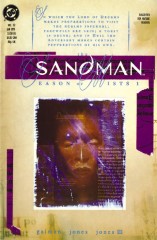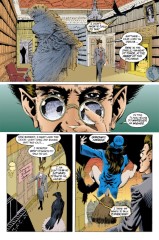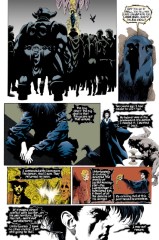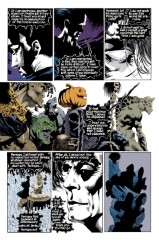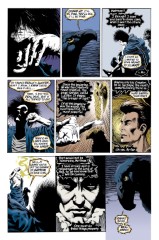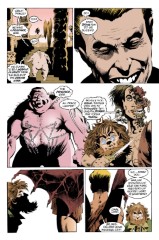Issue 22: "Season of Mists Chapter 1"
Neil Gaiman, Kelley Jones, and Malcolm Jones III
- First part of storyline, Season of Mists
- Second story reprinted in trade paperback Season of Mists
- Audible Act II Chapter 2
In which the Lord of Dreams makes preparations
to visit the realms infernal;
farewells are said;
a toast is drunk;
and in Hell the adversary makes
certain preparations of his own.
General: In the subtitle, "the adversary" is a translation of "Satan", a usual appellation for the ruler of Hell.
Title: The title of Season of Mists comes from John Keats' "To Autumn":
Season of mists and mellow fruitfulness,
Close bosom-friend of the maturing sun;
Conspiring with him how to load and bless
With fruit the vines that round the thatch-eaves run.
Cover: Note the extensive use of Latin text and Old German text in the composition of the cover. Anyone care to take a crack at them?
Page 1#
Panel 1
Avernus is a volcanic crater lake near Naples, Italy; it is mythologically the entrance to Hades. Gehenna is Hebrew for "valley of Hinnom", where sacrifices to Moloch (a non-Jewish deity) were made (II Kings 23:10). It has become identified with any place of extreme suffering.
Hades is from Greek mythology, being either the realm of the dead, or the god ruling that realm. Tartarus is a sunless abyss (recall the Sunless Lands from an earlier issue?) below Hades where Zeus imprisoned the Titans. Abaddon is from a Hebrew word meaning destruction, and is identified with the depths of Hell and the destroying angel of the bottomless pit of Rev 9:11. Sheol is the Hebraic afterlife, the concept of consciousness after death actually arising quite late in Jewish theology. We will also note that inferno is simply Latin for hell; and that Dante Alighieri's Inferno has served as a source for much of Gaiman's vision of Hell.
Note the columns belching forth smoke and flame, resembling mills and factories. An anti-industrial symbol?
Panel 2
Revisionists and apologists have often speculated that the dead were held in Hell only by their own desire for punishment.
Page 2#
Panel 1
The Library of Unwritten Stories. Psmith and Jeeves were favorite characters of comedy of manners author P.G. Wodehouse. Highly recommended farce. Raymond Chandler is a well-known American detective fiction author, one of the creators of the hard-boiled detective archetype. Lord Dunsany helped create the fantasy genre in the early part of this century. Erasmus Fry is a fictional writer created by Gaiman in Sandman #17. Charles Dickens was a 19th century populist fiction writer; The Mystery of Edwin Drood was an unfinished work of his. Sir Arthur Conan Doyle was a late 19th-early 20th century writer whose creation Sherlock Holmes is listed by Harlan Ellison as one of the five fictional characters known to every person on the planet (The others being Tarzan, Robin Hood, Superman, and Mickey Mouse).
Holmes, by the way, has appeared in the DCU universe from time to time. He appeared before the Crisis in Action Comics#283, Joker#6, and Sherlock Holmes#1. After the Crisis, he appeared in Detective Comics#572 and Eclipso#7-8.
Conan Doyle virtually invented the "consulting detective" archetype. James Branch Cabell was another early fantasist; Poictesme was his creation. G.K. Chesterton was a colorful author of the early 20th century; Fiddler's Green took his form in The Doll's House. Chesteron wrote a book entitled The Man Who Was Thursday, and left unfinished The Man Who Was October. He also contributed to the forming of the mystery genre with his amateur detective Father Brown. J.R.R. Tolkien elevated the fairy tale (or "high fantasy") to literature with his Hobbit and Lord of the Rings books. The Lost Road was an abandoned time travel story which would have linked his fictional world with our day and age, complementing C.S. Lewis's Space Trilogy. Lewis Carroll (a pen name for Charles Dodgson) wrote Alice's Adventures in Wonderland and Through the Looking Glass; Lucien is replacing Alice's Journey Behind the Moon.
I like to think that Lucien's record collection includes Traveling Wilburys Volume Two with both Roy Orbison and Del Shannon. See the Appendix for more background on the works in the Library.
Panel 5-6
"The Raven" was a poem by author Edgar Allan Poe, who almost singlehandedly created both mystery and the modern horror genre. It's central characters were an author and a raven who quoth "Nevermore" rather often. The movie The Raven, referred to here, is a camp classic featuring a duel between wizards Vincent Price and Boris Karloff, with Peter Lorre playing a sort of inept sidekick who is out for his own interests throughout the movie and ends up being turned into a raven. The movie also features a very young Jack Nicholson in a minor role.
Page 3#
Panel 2
Foreshadowing; at least it was obvious to me.
Panel 4
The Fashion Thing? In a Zatanna-esque costume?
Page 5#
- This is a recap of Sandman #9.
Page 6#
- This is a recap of Sandman #4.
Page 7#
Panel 1
Interesting information on the nature of the Endless.
Panel 4
This guy is Abudah. He also appears as Mervyn's sidekick in issue 60, pp. 21-23
Page 8#
Panel 3
Neil Gaiman has said that the raven companions of Dream dwell in Eve's cave.
Panel 4
In reference to the events of Swamp Thing ##27-30 and Annual #2, in which Matthew's mortal self made a deal with evil sorcerer Anton Arcane.
Panel 5
Samael ("Poison Angel") was the principal angel of death in medieval Jewish folklore, where he is under the control of God. Many alternate spellings exist. In the Targum, an Aramaic paraphrasing/translation of the Old Testament, Samael is identified with Lucifer, According to "Man Myth and Magic: an illustrated encyclopedia of mythology religion and the unknown", Samael was "incorrectly identified with Lucifer.". Robert Graves, a British poet, classicist, and translator, and much-admired writer of several works of and about myth and historical novels such as I, Claudius, translates Samael as "Venom of God". Hebrew myth calls Samael "Chief of all Satans" ("Satan" = "Adversary") and "the greatest prince in heaven".
Gustav Davidson's A Dictionary of Angels, 1967, also referencing Francis Barrett's The Magus, 1801, and S.L.Mather's The Greater Key of Solomon, 1889, breaks "Samael" down into /sam/ "poison" and /-el/ "angel". In Rabbinic literature, Samael is chief of the Satans and the angel of death. Glenn Carnagey, however, claims that "Samael" comes from the active participle of "shamah", "be high, lofty", affixed with /-el/ "god", and notes that the Hebrew word for angel is "malach". The /sh/ phoneme has shifted to an /s/ articulation, as with Shatan -> Satan.
Gnostic myths, however, have Samael as the "Blind God", a different Yahweh who made this flawed creation. This Samael may also be seen in the later work of Philip K. Dick, the late author of such notable science fiction works as Do Androids Dream of Electric Sheep, later to be filmed as Blade Runner.
Panel 8
Certainly, the rulers of realms exchange messengers to announce their visits.
Page 9#
Panel 1
An angel named Alcin is one of the guards stationed at the gates of the West Wind. This may be the same being, after the Fall.
Panel 3
The half-faced woman, who is named in the next issue, says "Shut up, scum. Speak when you are spoken to. Get down on your knees."
Panel 6
In Judeo-Christian mythology, Cain was the first born of the first two people; he committed the second sin of the world by murdering his younger brother (Abel, whom we've seen before). Satan is regarded as the causative force behind sin in this mythology.
Page 10#
Panel 4
"Eat his face..."
Panel 6f
This is from Genesis 4:15-16, King James translation, and tells of Cain's punishment by the Creator.
Panel 9
"But my lord Lucifer"; this creature has teeth, so should be able to make "l" sounds with no difficulty. In general, though, labial sounds like "m" have been shifted back in the mouth, since the creature has a problem with its lips.
I Mortis5555@aol.com think the reason she can't say an 'L' sound is because she has no tongue.
Or at least not a whole tongue. Also, Gaiman seems to imagine most of these characters with English accents, so then the sound she might be making instead of "er" would be more like "uh". (probably why it's spelled "Ruszcivah" instead of "Ruszciver"). He might be intending it to sound more like "Uszcivah".
Page 11#
Panel 1-3
No direct confirmation of Lucifer's story. Gnostics included several early heretical Christian sects (possibly the Mandaeic sect) who believed that Christ had no material form. The obvious conclusion to be drawn from panel 3 is that it's not what faith you espouse that determines where you go when you die, which is in direct contradiction to most major faiths' tenets as preached to the living.
Page 12#
Panel 1-2
These are Lyta Hall and her son; Carla is a new character.
We last saw Lyta and the child in Sandman #12, q.v. It is worth noting that Daniel is linked not only to Dream by his gestation, but also to the Triple Goddess through his grandmother, who was bound to the Furies by an agreement made in World War II that granted her superpowers with which to fight the Nazis. Lyta inherited those powers.
Page 14#
Panel 4
I believe the Biblical Daniel was known for interpreting dreams. In Hebrew, it means "The Lord is my judge."
Page 15#
Panel 3
The father's quote is from the movie The Wizard of Oz.
Is there a reference for Cecilie Latour?
Page 16#
Panel 2
This is Hob Gadling, from Sandman #13. Queen Elizabeth I (Queen Bess) quotes from a common version of the tale of Roger Bacon's mechanical head. Supposedly, Bacon built a mechanical head, but could not get it to speak. He went to sleep, but instructed his apprentice to wake him if the head began to speak. After some time, the head spoke, and said "Time is", but the apprentice was too afraid of his master to dare to wake him. A second time, the head spoke, saying "Time was", and again the apprentice feared to disturb his master's slumber. Finally, the head said "Time's past", then exploded, and with this, the apprentice woke his master, but the head could not be repaired and never spoke again. What punishments Bacon inflicted upon his apprentice are lost along with the slaggard's name.
Note that Hob dreams of himself with a beard but is actually clean-shaven.
Panel 6
Lafite-Rothschild is a large winery in the Medoc region of southern France, a bit north of Bordeaux and near the Atlantic. Each year it produces about 800 barrels of what is described as "fabulously expensive wine" by the World Atlas of Wine, an oenologist's standard reference work. The wine is considered to be a Bordeaux. The significance of the 1828 vintage is unknown.
Page 18#
Panel 1
Neil Gaiman says: "Hob Gadling's toast is original (although I suspect I had Ambrose and Nathaniel's pledge from Hope Mirlees' novel Lud in the Mist in the back of my head somewhere when I wrote it; the rhythms are similar)." See the appendix for a commentary on Mirlees.
Panel 7
The bottle probably wasn't there before the dream (see page 16 panel 1, but our view is at least partially obscured by the sleeping bodies).
Page 19#
Panel 2
This refers to events in the first several issues of The Demon, the newest version of that title. The "little yellow rhymer" is Etrigan, the lead character of that book.
Panel 3f
Originally, the trinity consisted of Lucifer, Azazel, and Beelzebub; Azazel was replaced by Belial; then Etrigan's coalition deposed all three. Lucifer is saying here that he was never forced to share power, that he merely couldn't be bothered to put down the rebels.
It is perhaps important to note that DC's Hell has no set continuity at this moment. The Demon, at least, has stayed out of Hell since Season of Mists concluded, but a major plot device in Hellblazer depends on the triumvirate being intact and stable.
It is not known if Gaiman likes sharing Hell with other authors (particularly Alan Grant of The Demon, whose vision of Hell is primarily humorous, and even includes room for "Stanley and His Monster"), but given the hissy Gaiman allegedly threw over Death's unauthorized appearance in Captain Atom, it's a fair bet that he'd prefer to have "first refusal" rights on any story dealing with demesnes that figure in Sandman.
Page 20#
Panel 1
A quote from Milton's Paradise Lost. Milton was blind for most of his writing career, forced to dictate his works to a secretary.
Page 21#
Panel 6
This is Nada.
Page 22#
Panel 3
Cain is exaggerating. Lucifer didn't actually harm him, did he; he does bear some respect for the creator's mark. See page 10 panel 8.
Credits
- Originally collated and edited by Greg Morrow.
- Dennis c hwang hwa5@midway.uchicago.edu, David Goldfarb (goldfarb@ocf.berkeley.edu), Tom White (twhite@mozart.amd.com), and Michael Bowman (mbowman@andromeda.rutgers.edu) corrected my memory of Poe's title for that darned bird poem. Dennis added some information on the movie. Michael and David named the title of the GK Chesterton work, and Michael added some information on Tolkien's unfinished book. Michael also tentatively identified Alchino.
- Michael also identified Robert Graves and corrected a Dickens mistake.
- Max Rible (rible@vorpal.ucsb.ed) quoted Keats as a possible source for "Season of Mists".
- Tanaqui C. Weaver (cen@vax.oxford.ac.uk) passed on Gaiman's view of Hob's quote and herself added a historical note about Chesterton and an opinion of wine.
- Jim W Lai (jwtlai@watcgl.waterloo.edu) doesn't think Hob's wine was there when we first saw him.
- Jim, Michael, Pete Hartman (pwh@bradley.bradley.edu), and Eric Rescorla (rescorla@rtnmr.chem.yale.edu) gave various and sundry sources for Samael.
- David R. "The Orb" Henry UD137927@NDSUVM1.BITNET corrected my crassness.
- Mike Chary charyma@wkuvx1.bitnet corrects my Jewish theology, identifies Robert Graves, speculated about Gnostic sects, brought in the Demon, and interpreted Cain's distress as due to Lucifer's lack of respect for the Creator and by extension Dream.
- Ian Lance Taylor (ian@airs.com) looked up the wine and noted Hob's beard.
- Joel Tscherne (ac985@cleveland.freenet.edu) tracked down a Biblical reference.
- Dave Stobbe dave.stobbe@canrem.com passed on a reference to Keats from Compu$erve's William Sargent (100010,612) that duplicated Max Rible's effort.
- Scott Martin 92rsm@williams.edu, who also wrote the Appendix, caught the dark mills of Hell, and divulged details of Daniel Trevor-Hall's spiritual ancestry. He also pointed out Dave McKean's textual inclusion on the cover.
- Francis A Uy fau@po.cwru.edu hit the texts for information on Jewish and Christian mythology, and Glenn Alan Carnagey Jr lf7z@quads.uchicago.edu followed up on his lead.
- Colonel G.L. Sicherman gls@windmill.att.com explained the Queen Bess quote and displayed oenological knowledge, which sounds like something he should be cited for, and is!
- Mortis5555@aol.com added a comment on Mazikeen's speech
- Ralf Hildebrandt added more details.
Appendix: Early Fantasists
Scott Martin 92rsm@williams.edu, who qualifies as a bonafide expert on early fantasy, includes a long commentary on Lud in the Mist and Lucien's Library which I append intact:
LUD-IN-THE-MIST by Hope Mirrlees was written around the same time that Cabell and Dunsany were writing; the book concerns Golden Apples from Fairyland that float into the bourgeois, vaguely Welsh (but vaguely Flemish, too) town of Lud-in-the-Mist. Thereupon the Story Hinges. I remember the toast very vaguely (I'll have access to my copy again in a few weeks and will post more fully then...), but I think you're right on in insisting that "Season of Mists" as a title derives much more from the poem than the title of this little-known but BEAUTIFUL novel. [Editor's note: Scott's comment stems from an early misperception on my part of the relationship between Keats, the title of the story, and the toast.] In fact, the New York Times review of Books of Magic #1 includes a comparison of another fantasy work (I've temporarily forgotten which) to the Mirrlees.
LUD-IN-THE-MIST was, I believe, most recently published in the Ballantine Adult Fantasy series in March 1970. It is likely that this is the edition that Gaiman himself is familiar with: Ballantine Adult Fantasy also included editions of Dunsany, Cabell, and Chesterton's MAN WHO WAS THURSDAY.
On Lucien's Library: GOD! I would kill to read the Dunsany, Cabell, or Chesterton. It is likely (but not certain) that POICTESME BABYLON is the never-written capstone of Cabell's 26 volume (!!!) epic of the descendants of Don Manuel, "mythical" hero and ruler of medieval POICTESME (wherein was set the controversial JURGEN, the second-biggest "obscenity" of the 1920s literary world). This epic "the Biography of Don Manuel," extends from mythic/medieval Poictesme (a "county" of France, from which Clark Ashton Smith derived his "Averoigne") to 1920s Lichfield, Virginia, with side tours into Faerie, other realms, and a wide range of Heavens and Hells.
POICTESME BABYLON must be the unhoped-for climax of the Biography in which everything finally comes together and Cabell's (insanely) complex philosophy finally resolves. (Incidentally, "Horvendille" from Sandman#2 is not "just" a demiurge...I'll post later, but for now let me say that he is NOT from Dunsany...if so, I've never heard of the reference, and Lin Carter writes in the intro to Cabell's THE CREAM OF THE JEST that his name "derives ultimately from SAXO GRAMMATICUS". Horvendille's a complicated guy: he's demiurge and also a daydreamer in Lichfield, and, not insig- nificantly, Don Manuel also was a pigherder)
The Dunsany...! Dunsany, incidentally, was Lovecraft's hero, from whence came the early Lovecraft stories and DREAM-QUEST OF UNKNOWN KADATH. I think he would have preferred being referred to as "Irish" rahter than "British"; Yeats and the rest of the "Celtic Twilight" crowd adored him. Judging from his Earthly output, THE DARK GOD'S DARLINGS would have been that pearl beyond price for Dunsany fans, a full novel set in Dunsany's world of Pegana (as detailed in THE BOOK OF WONDER et c.). The title does not sound like Dunsany's style for naming his books of short stories (he wrote comparatively few novels), but it also sounds too dark and fatalistic for it to be at all similar to his later novel-length fantasies, most of which are set in a sort of "Orlando Furioso" Spain.
As for the Chesterton, I can hardly imagine a MAN WHO WAS THURSDAY with five extra characters. Do you know THE MAN WHO WAS THURSDAY? It's about a poet who is drafted by a top secret Poetry Division of an INTERPOL like organization to infiltrate a Europe-spanning Anarchist Conspiracy. The seven members of the Anarchist Council are identified by a day of the week; thus, our poet hero is "Thursday." The rest is transcendence.... (oh, BTW, in #14, "Gilbert's" story is not original to the "real" Chesterton but seems to derive instead from Robert Darnton's THE GREAT CAT MASSACRE)
Last modified by Richard Munn on 2023-08-15 - Updated issue inclusion blocks, adding extra trades, and audible/netflix episodes
[edit this page] [page history]
